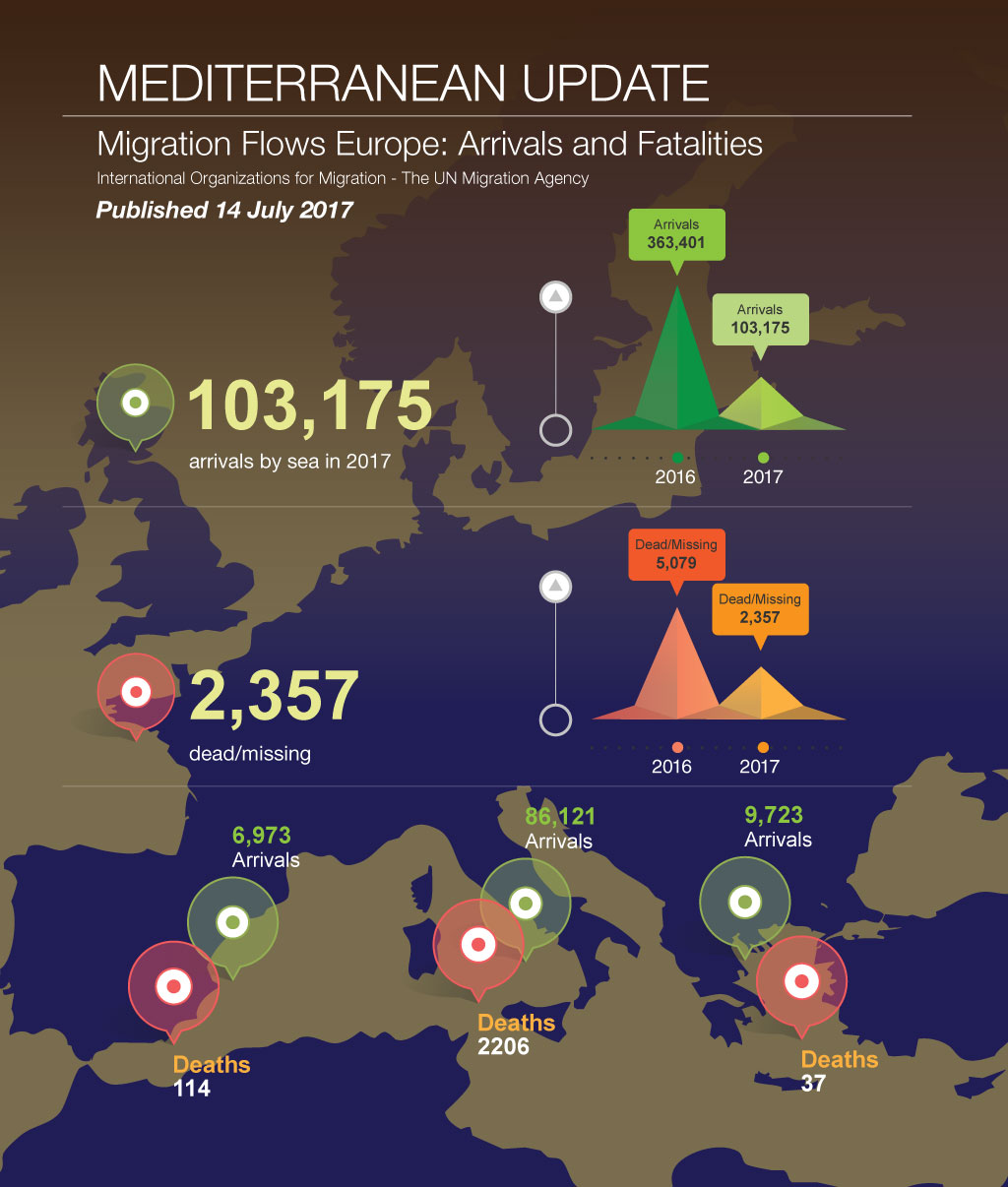Illegal trafficking of immigrants and refugees by sea routes
Every year thousands of immigrants or refugees leave their homelands and travel many miles by sea in an attempt to find better living and work conditions or seeking international protection against threats to their life. These desperate people very often risk their lives using overcrowded, old and decrepit vessels as they try to reach to their destination (in most of cases are the Southern European countries). Many of them do not manage to reach their final destination as accidents are common and many lives are lost at sea.
The purpose of this article is to highlight the problem caused from the illegal movement of migrants and refugees via sea and to focus to the effects it has on merchant shipping and yachts sailing in the Mediterranean Sea.

The United Nations (UN) 1951 Refugee Convention, in article 1.A.2, adopted the following definition of “refugee” to apply to any person who:
“Owing to well-founded fear of being persecuted for reasons of race, religion, nationality, membership of a particular social group or political opinion, is outside the country of his nationality and is unable or, owing to such fear, is unwilling to avail himself of the protection of that country; or who, not having a nationality and being outside the country of his former habitual residence as a result of such events, is unable or, owing to such fear, is unwilling to return to it.”
The United Nations High Commissioner for Refugees (UNHCR) in addition to the 1951 definition, recognizes such persons as refugees: “Who are outside their country of nationality or habitual residence and unable to return there owing to serious and indiscriminate threats to life, physical integrity or freedom resulting from generalized violence or events seriously disturbing public order.”
On the other hand immigration is the international movement of people into a destination country of which they are not natives or where they do not possess citizenship in order to settle or reside there, especially as permanent residents or naturalized citizens, or to take-up employment as a migrant worker or temporarily as a foreign worker.
Illegal immigration is the entry of a person or a group of persons across a country’s border, in a way that violates the immigration laws of the destination country, with the intention to remain in the country.
Nowadays some of the major mass migrations routes are Mediterranean Sea Route, Central American Route and Southeast Asian Route. During this period of time the Mediterranean Sea is the most interesting area concerning the illegal immigration and refugees who use the sea routes to move.
The International Organization for Migration (IOM) at the beginning of the year 2017 reported preliminary totals for all 2016 migrant and refugee arrivals to Europe via the Mediterranean Sea, as well as estimated fatalities. Arrival totals were 363,348 split almost evenly between Italy and Greece, with much smaller numbers arriving in Malta, Cyprus and Spain. Fatalities and missing migrants reached at least 5,079.

IOM believes many more deaths at sea may have gone unreported last year – in the Mediterranean and elsewhere – particularly between North Africa and Spain, where data collection often has been sporadic and many smaller vessels are believed to have been lost without detection (source https://www.iom.int/news/mediterranean-migrant-arrivals -top-363348-2016-deaths-sea-5079).
IOM also reports that 103,175 migrants and refugees entered Europe by sea in 2017 through 12 July, with almost 85 per cent arriving in Italy and the remainder divided between Greece, Cyprus and Spain. This compares with 240,014 arrivals across the region through 12 July 2016 (source https://www.iom.int/news/mediterranean-migrant-arrivals-reach-103175-2017-2357-deaths).
From the above, we conclude that the illicit trafficking of migrants and refugees via sea routes poses serious risks to their lives but it also affects the safety of ships sailing in these areas.
What, however, is the impact on the safety of ships and crews from the illegal transit of migrants and refugees with unseaworthy vessels?
In accordance with the law of the sea the captain of the vessel has the obligation to offer assistance to any person found at sea in danger. More specifically the United Nations Convention on the Law Of the Sea (UNCLOS 1982) in Article 98 paragraph 1 (Duty to render assistance) provides that:
1. Every State shall require the master of a ship flying its flag, in so far as he can do so without serious danger to the ship, the crew or the passengers:
(a) To render assistance to any person found at sea in danger of being lost;
(b) To proceed with all possible speed to the rescue of persons in distress, if informed of their need of assistance, in so far as such action may reasonably be expected of him;
(c) After a collision, to render assistance to the other ship, its crew and its passengers and, where possible, to inform the other ship of the name of his own ship, its port of registry and the nearest port at which it will call.
Also the International Convention for the Safety of Life at Sea (SOLAS Convection 1974) in Regulation 33 refers that :
“The master of a ship at sea which is in a position to be able to provide assistance on receiving information from any source that persons are in distress at sea, is bound to proceed with all speed to their assistance, if possible informing them or the search and rescue service that the ship is doing so. This obligation to provide assistance applies regardless of the nationality or status of such persons or the circumstances in which they are found. If the ship receiving the distress alert is unable or, in the special circumstances of the case, considers it unreasonable or unnecessary to proceed to their assistance, the master must enter in the log-book the reason for failing to proceed to the assistance of the persons in distress, taking into account the recommendation of the Organization, to inform the appropriate search and rescue service accordingly.”
When a ship is required to provide assistance to a ship in distress, the captain must have taken account of various issues such as the safety of the ship and her crew, its assistance capabilities and what other actions it he should take concerning the provision of information to the competent authorities.
However, often the captain is confused about his exact responsibility and his crew responsibility when detecting a vessel at risk in the sea, especially when this vessel appears to be full of migrants or refugees.
For this purpose a guide to principles and practice as applied to refugees and migrants has been prepared jointly by the International Maritime Organization (IMO), the International Chamber of Shipping (ICS), and the Office of the United Nations High Commissioner for Refugees (UNHCR).
The guide is available in Arabic, Chinese, English, French, Russian and Spanish (http://www.imo.org/en/OurWork/Facilitation/personsrescued/Pages/Default.aspx).
The guide outlines some of the main actions that a captain must take when requested to provide assistance to the rescue of persons in distress at sea (such as to check the ship’s equipment, the implementation of the plans and procedures concerning the safety and security of the crew and the ship, the provision to the local Rescue Coordination Centre (RCC) of all necessary information etc).
An important factor that a ship’s captain has to take into account when providing assistance to a ship in distress, not mentioned in this handbook, is the possibility that the refugees and migrants traveling without documentation are often facilitated by smugglers, who in some cases may be dangerous and armed.
To deal with such a possible case, the captain and crew should be in alert to detect the suspect behavior of such individuals and be prepared to react appropriately.
A very important issue is the area of concentration and accommodation of the survivors. This site must be chosen on the basis of both the safety of these people and of the ship and her crew. Also, a plan with certain duties for the crew, preplanned actions and necessary equipment to confine the immigrants (especially the dangerous ones) must exist, in order to ensure the vessel’s safety.
Among other issues that a captain will be required to handle is also to provide health care to people in need. The immigrants or the refugees may be suffering from hypothermia and dehydration or starvation as well as from bodily injuries. But what deserves particular attention is that some of the survivors may be suffering from contagious diseases. In any case the crew must treat them with humanity within the capabilities and limitations of the vessel. In order to deal with these incidents, the appropriate pharmaceutical and sanitary equipment should be available on board.
Finally, an important factor that must always be taken into account is the issue of the religion of these people, a very important detail in order to avoid any bad reactions from the rescued persons to keep them calm and cooperative.
In any case, a ship’s captain may decide not to travel to areas considered to be high risk of trafficking of refugees and migrants.
Conclusion
Crossing maritime borders using unseaworthy boats is an extremely dangerous experience. Illegal trafficking of people by sea in the coming years is expected to increase exponentially and is going to affect seafarers who are sailing in respective areas, especially in the Mediterranean. The rescue of refugees and migrants at risk in the sea is a challenge for the captain and the crew because it can affect both the safety of seafarers and guests and the ship. Equally important, it is necessary to know the obligations and responsibilities arising from the international conventions. Therefore, knowledge, proper preparation and continuous training of the crews can prevent unpleasant situations for the ships and those onboard.

